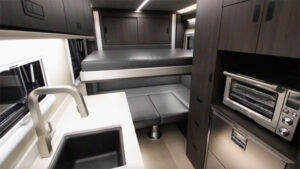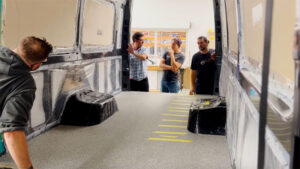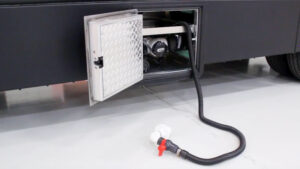RV Products
Advanced RV - Where 'Subtract" or 'Less' Could be the Right Answer for your Class B RV
Good morning, I’m Mike with Advanced RV, we’ve been 12 years in business now, and it’s kind of a time for reflection and reaffirming our vision. Recently, I read a book called “Subtract,” and it resonated because I think that that’s the way we have approached the Class B motorhome innovation process that we’ve started 12 years ago. And the book starts with the author playing Legos with his son, and they build two towers, and they need to span the towers, but they’re different heights. So, his son takes blocks off the tall tower so that they’re even and he puts a spanner in, the father adds blocks to the shorter tower to span. Same result, but a different approach, and the research cited in the book talks about how our inclination is to add things, when we design, when we come up with a problem, we add, we add. And I realized reading the book that that’s not what we do at ARV.
 We tend to subtract, we go back to first principles, we go back to the core objectives that our clients have, and from those core objectives we create a new design, and usually that design involves subtracting. You know, a good example is when we started, every RV Class B and bigger had a generator and it had gel batteries, the better ones, or lead-acid batteries. And we started looking at that and we decided, “You know, it would be really good if we could subtract propane from the design, so you wouldn’t have the hassle of filling propane, the hassle of carrying it.” So we started looking at eliminating the generator, and we came up with our first lithium batteries, and we’ve been installing lithium batteries, larger and larger, lighter and lighter, and better placed and safer, for the last 12 years.
We tend to subtract, we go back to first principles, we go back to the core objectives that our clients have, and from those core objectives we create a new design, and usually that design involves subtracting. You know, a good example is when we started, every RV Class B and bigger had a generator and it had gel batteries, the better ones, or lead-acid batteries. And we started looking at that and we decided, “You know, it would be really good if we could subtract propane from the design, so you wouldn’t have the hassle of filling propane, the hassle of carrying it.” So we started looking at eliminating the generator, and we came up with our first lithium batteries, and we’ve been installing lithium batteries, larger and larger, lighter and lighter, and better placed and safer, for the last 12 years.
Another simple example of subtraction is that, many clients, when they bought a Class B motorhome, one of their first trips was to Target or somewhere to buy a bed topper, because of the way the beds were designed and configured, so they had to figure out a place to store it, they had to deploy it at night and put it away in the morning. And we just decided, “Well, let’s subtract the need for a bed cover,” so we’ve been building beds in our facility here and offering clients custom upholstery on those beds ever since we started.
Other examples are automatic leveling system, which subtracts the need to carry blocks and mess with blocks. Also, I’ve used the levelers to get unstuck before, and so that eliminates the need to carry a shovel, although shovels look cool when they’re hanging on the outside, and manual jacks, to jack up if you’re off-road and get stuck. So, again, subtraction.
We subtracted the noise in air conditioners. Very early on, measured the effectiveness of the air conditioners, different brands that were available, and the sound levels, and we found an Australian-designed air conditioner that greatly lowered the sound and the noise of the air conditioner when operating.
 Same thing with the heating system, the heating system that we designed is more effective and quieter, so we took away noise. We also took away handling issues by installing our huge tanks, fresh, gray, and black, under chassis. We also did the same with our battery systems, with the maximum ground clearance. So we subtracted issues hanging down from the van, and we also improved safety and handling thinking about every aspect of lowering our center of gravity in our builds. Our dump-and-fill, we don’t have a 3-inch hose, we have a inch-and-a-half diameter hose that actually stores in a compartment, it’s continuously hooked up, so it takes about four minutes to empty gray and black tanks. So all these things subtract care, subtract thinking, and subtract the hassles that used to be involved with Class B motor-homing.
Same thing with the heating system, the heating system that we designed is more effective and quieter, so we took away noise. We also took away handling issues by installing our huge tanks, fresh, gray, and black, under chassis. We also did the same with our battery systems, with the maximum ground clearance. So we subtracted issues hanging down from the van, and we also improved safety and handling thinking about every aspect of lowering our center of gravity in our builds. Our dump-and-fill, we don’t have a 3-inch hose, we have a inch-and-a-half diameter hose that actually stores in a compartment, it’s continuously hooked up, so it takes about four minutes to empty gray and black tanks. So all these things subtract care, subtract thinking, and subtract the hassles that used to be involved with Class B motor-homing.
 Another thing that comes to mind is our process, our process not only is through subtraction for hard designed things, but of conversation, learning the client’s needs has been developed over the last 12 years. We don’t have a menu, because there’s no limit to what clients can do, so that they can visualize a different use pattern where things are easier and where they don’t have to fuss with the van year over year, ou just add to the things that you want to add to and you never question the things from past years that maybe aren’t appropriate anymore. So part of our process is to do zero-based thinking about how we communicate with clients and how we listen to clients. The other thing we’ve subtracted, and this was a concept from the beginning, but it was pretty radical at the time to have a custom production like we are, a motorhome company and manufacturing service without dealers. We have nothing against dealers, I’ve purchased in the past years from dealers, but we wanted to subtract the insulation, the communication hassles for our clients of going through dealers and then back to us. When they have a service question or a service problem, they get a technical person any day of the week and any time of the day. So we have subtracted a lot of communication, potential hassles for our clients, and potential opportunities for miscommunication, and that’s been a lot of fun.
Another thing that comes to mind is our process, our process not only is through subtraction for hard designed things, but of conversation, learning the client’s needs has been developed over the last 12 years. We don’t have a menu, because there’s no limit to what clients can do, so that they can visualize a different use pattern where things are easier and where they don’t have to fuss with the van year over year, ou just add to the things that you want to add to and you never question the things from past years that maybe aren’t appropriate anymore. So part of our process is to do zero-based thinking about how we communicate with clients and how we listen to clients. The other thing we’ve subtracted, and this was a concept from the beginning, but it was pretty radical at the time to have a custom production like we are, a motorhome company and manufacturing service without dealers. We have nothing against dealers, I’ve purchased in the past years from dealers, but we wanted to subtract the insulation, the communication hassles for our clients of going through dealers and then back to us. When they have a service question or a service problem, they get a technical person any day of the week and any time of the day. So we have subtracted a lot of communication, potential hassles for our clients, and potential opportunities for miscommunication, and that’s been a lot of fun.
The other thing we’ve done here together at ARV, we started with a trial about, well, two years ago, we subtracted a day of work, and we did that by mindfully looking at how we work, how we have meetings, how we do everything we do, and everybody has and continues to subtract things that are not productive from their work days. We’ve done this without subtracting satisfaction and without adding stress, and so we’re almost two years now into our four-day week, and enabled everybody to have a three-day weekend.
Thanks for helping us get to where we are, we really are having fun with this process, and we’re continuing to subtract.

